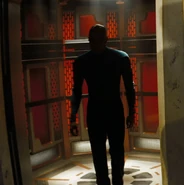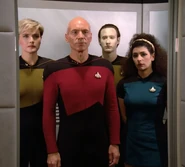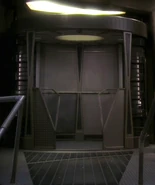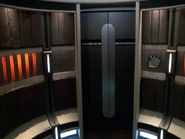Tag: sourceedit |
Tag: sourceedit |
||
| Line 42: | Line 42: | ||
{{bginfo|This may be a joke taken from a well-known ''Star Trek: The Original Series'' blooper which shows the turbolift opening only partially.}} |
{{bginfo|This may be a joke taken from a well-known ''Star Trek: The Original Series'' blooper which shows the turbolift opening only partially.}} |
||
| + | |||
[[File:Lwaxana and Odo in turbolift 2369.jpg|thumb|Lwaxana Troi and Odo inside a turbolift in 2369]] |
[[File:Lwaxana and Odo in turbolift 2369.jpg|thumb|Lwaxana Troi and Odo inside a turbolift in 2369]] |
||
In [[2365]], when the {{USS|Enterprise|NCC-1701-D|-D}} scanned the logs from the {{USS|Yamato}}, they contracted a [[computer virus]], which severely affected all critical systems aboard the ship. One of these systems were the turbolifts, and a malfunction resulting in highly increased acceleration rates and tremendous direction shifts, injuring [[Lieutenant]] [[Geordi La Forge]] inside, practically throwing him onto the bridge. ({{TNG|Contagion}}) |
In [[2365]], when the {{USS|Enterprise|NCC-1701-D|-D}} scanned the logs from the {{USS|Yamato}}, they contracted a [[computer virus]], which severely affected all critical systems aboard the ship. One of these systems were the turbolifts, and a malfunction resulting in highly increased acceleration rates and tremendous direction shifts, injuring [[Lieutenant]] [[Geordi La Forge]] inside, practically throwing him onto the bridge. ({{TNG|Contagion}}) |
||
| Line 49: | Line 50: | ||
Also in 2368, a collection of [[quantum filament]]s collided with the ''Enterprise''-D, disabling power to many of the main systems, including [[life support]], main engines, and [[computer]] control. At this time, Picard and some children were in a turbolift, and Picard decided to climb the emergency shaft in case the unstable turbolift fell in the shaft. Using a makeshift rope made from optical cable, Picard and the children escaped the doomed turbolift and climbed to the upper decks. ({{TNG|Disaster}}) |
Also in 2368, a collection of [[quantum filament]]s collided with the ''Enterprise''-D, disabling power to many of the main systems, including [[life support]], main engines, and [[computer]] control. At this time, Picard and some children were in a turbolift, and Picard decided to climb the emergency shaft in case the unstable turbolift fell in the shaft. Using a makeshift rope made from optical cable, Picard and the children escaped the doomed turbolift and climbed to the upper decks. ({{TNG|Disaster}}) |
||
| − | In [[2369]] [[Constable]] [[Odo]] and [[Ambassador]] [[Lwaxana Troi]] were trapped in a turbolift for several [[hour]]s after an [[alien]] [[probe]], later called "[[Pup]]" by [[Miles O'Brien]], damaged several of the station's systems. [[Kira Nerys]] informed Odo not to shape-shift his way out through the [[turboshaft]], as Cardassian turbolifts have exposed [[multi-phase alternating current]] running through the [[positioning mechanism]]. ({{DS9|The Forsaken}}) |
+ | In [[2369]] [[Constable]] [[Odo]] and [[Ambassador]] [[Lwaxana Troi]] were trapped in a turbolift for several [[hour]]s after an [[alien]] [[probe]], later called "[[Pup]]" by [[Miles O'Brien]], damaged several of the station's systems. [[Kira Nerys]] informed Odo not to shape-shift his way out through the [[turboshaft]], as [[Cardassian]] turbolifts have exposed [[multi-phase alternating current]] running through the [[positioning mechanism]]. ({{DS9|The Forsaken}}) |
| + | |||
| + | {{bginfo|The turbolift malfunction in "The Forsaken" was an attempt to save finances. "''I figured putting two people in an elevator has got to save money somewhere,''" explained [[Michael Piller]]. (''[[Captains' Logs Supplemental - The Unauthorized Guide to the New Trek Voyages]]'', p. 54)}} |
||
| − | In [[2372]], the |
+ | In [[2372]], the Cardassian [[terrorism|terrorist]] group the [[True Way]] [[sabotage]]d one of Deep Space 9's turbolifts, as part of a scheme to assassinate [[Bajoran]] [[First Minister]] [[Shakaar Edon]]. ({{DS9|Crossfire}}) |
== Background information == |
== Background information == |
||
Revision as of 09:45, 28 February 2015
AT: "xx"
A map of the turbolift system aboard the refit Constitution-class USS Enterprise
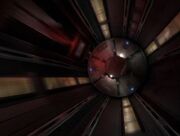
View of a turbolift from the outside
Located on board most starships and space stations, the turbolift, or turbo-elevator, provides both vertical and horizontal transportation for personnel through turboshafts between key sections of a ship. In the 2270s, the turbolift's tactile interface was succeeded by voice command operation.
Turbolift specifications
The turbolift personnel transport system is a network of inductively powered transport tubes allowing the volume of the ship to be traversed in a high-speed manner.
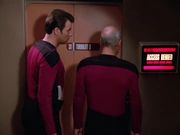
Turbolift access denied
Many Starfleet turbolifts are comprised of a lightweight duranium-composite framework supporting a cylindrical personnel cab constructed from microfoamed duranium sheeting. Mounted longitudinally along the exterior of the cab are three linear induction motors that provides the motive force. Electromagnetic conduits located along the length of each turboshaft provide power to these motors, allowing accelerations up to ten meters per second squared. (citation needed • edit) To counter such high acceleration speeds, an inertial dampener is usually installed at the base of the cab to provide crew comfort, eliminating some (although not all) of the acceleration effects. In some Starfleet vessels, a plan of the ship is displayed along the back of the turbolift, allowing for directional assistance in the absence of computer access. Turbolifts can also be locked down in the event of a security incident, blocking access to critical areas of the ship, such as the main bridge. (TNG: "11001001")
NX-class starships needed only a button to be pressed to specify which deck to travel to. (ENT: "Cold Front") Incorporated in the design of Constitution-class turbolifts were small handles on the interior, allowing for transport without the use of voice commands. At some point, it became necessary to use both the handle and to submit a voice command on board Constitution-class ships. (DS9: "Trials and Tribble-ations") Later refits phased out any analog interfaces and featured auditory receivers allowing passengers to use voice commands to direct the turbolift. Upon receipt of the voice command, the command queries the network, allowing for computation of the most optimal route to the destination. Such routes factor in the presence of other turbolifts already in operation. The auditory receivers also automatically scan for voiceprint authentication, allowing for select personnel access to restricted areas. Turbolifts from the 23rd century also featured communication panels to allow communication with other sections of the ship without the need for a communicator. (TOS: "Elaan of Troyius")
While most starship turbolifts were enclosed, some turbolifts remained open when at rest, in the style of an elevator built in the early-to-mid-20th century. The Cardassians built such a turbolift on Terok Nor when it was in operation, and it was still in use by Starfleet on the renamed Deep Space 9. Once this turbolift became activated, it became enclosed as a precautionary measure. These turbolifts' positioning mechanisms were powered by multi-phase alternating current. In ships and stations that contain turbolift doors that remain closed while not in use, the doors will often be unresponsive in low or no power situations.
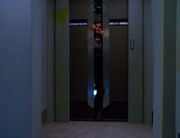
With Voyager at low power, Janeway is forced to open the turbolift doors by hand.
In a Galaxy-class starship, turbolifts are regulated by turbolift control and an average of ten turbolift cars are in service at any one time. Some peak usage times, such as change-of-shift, can call for a doubling of the turbolift cars with only a 22% decrease in efficiency. The reason this is possible is because the turboshaft network is designed with the specific purpose of allowing multi-access loops and thus permitting a flexible route for each turbolift car. (citation needed • edit)
When battle stations are ordered, all turbolift cars may be subjected to deactivation pending the authorization of the commanding officer. In such cases, personnel are still free to move about the ship via a network of vertical ladders and Jefferies tubes.
While docked at a Starbase, the turboelevator network is connected to the network of the adjacent Starbase, allowing for easy passage without the use of an umbilical dock. This is accomplished through a connection point located at the upper terminus of turboshaft two, leading from the main bridge. When linked, turbolifts cars may travel freely between the ship and areas of the Starbase. (Star Trek: The Next Generation Technical Manual; TOS: "Where No Man Has Gone Before"; Original Series films; Star Trek: The Next Generation)
Turbolift incidents
In 2287, after the construction of the new USS Enterprise-A, many systems were still nonfunctional, including the warp drive. After shore leave, when Kirk entered the main bridge with Spock and McCoy, Kirk was annoyed by the turbolift only opening partially. (Star Trek V: The Final Frontier)
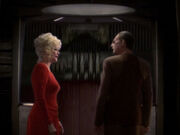
Lwaxana Troi and Odo inside a turbolift in 2369
In 2365, when the USS Enterprise-D scanned the logs from the USS Yamato, they contracted a computer virus, which severely affected all critical systems aboard the ship. One of these systems were the turbolifts, and a malfunction resulting in highly increased acceleration rates and tremendous direction shifts, injuring Lieutenant Geordi La Forge inside, practically throwing him onto the bridge. (TNG: "Contagion")
In 2368, a metal parasite infested the Enterprise-D when it destroyed an asteroid about to collide with a planet. This parasite began to ingest the nitrium from all critical systems. One of these systems was the turbolifts, as the circuitry was being broken down as Captain Picard and Lieutenant Commander Data were still inside, although no incident seemed to occur. (TNG: "Cost of Living")
Also in 2368, a collection of quantum filaments collided with the Enterprise-D, disabling power to many of the main systems, including life support, main engines, and computer control. At this time, Picard and some children were in a turbolift, and Picard decided to climb the emergency shaft in case the unstable turbolift fell in the shaft. Using a makeshift rope made from optical cable, Picard and the children escaped the doomed turbolift and climbed to the upper decks. (TNG: "Disaster")
In 2369 Constable Odo and Ambassador Lwaxana Troi were trapped in a turbolift for several hours after an alien probe, later called "Pup" by Miles O'Brien, damaged several of the station's systems. Kira Nerys informed Odo not to shape-shift his way out through the turboshaft, as Cardassian turbolifts have exposed multi-phase alternating current running through the positioning mechanism. (DS9: "The Forsaken")
In 2372, the Cardassian terrorist group the True Way sabotaged one of Deep Space 9's turbolifts, as part of a scheme to assassinate Bajoran First Minister Shakaar Edon. (DS9: "Crossfire")
Background information
In the script of TOS: "Where No Man Has Gone Before", this type of elevator is referred to as "a high-speed cab with many capabilities (to permit development in future episodes)." The script goes on to describe the effect of the turbolift in motion; "We will see flickering lights of the rapidly accelerating ship's elevator passing deck after deck."
Garfield Reeves-Stevens explains how, for "Where No Man Has Gone Before", the effect of a turbolift moving between decks in a single shot was achieved; "It's just a really clever, simple trick, where they just put up a wall, I guess a 'wild' wall, in front of the bridge, and actually shot the turbolift on the bridge. And as soon as the turbolift doors close, then they started the light beams going up the side, just rolled away the wild wall and then when the turbolift doors open, they're there." (Starfleet Access for "Where No Man Has Gone Before", TOS Season 1 Blu-ray special features)
The presence of only one turbolift accessible from the bridge of the Enterprise in TOS came under some scrutiny, sometimes being criticized because, if that single turbolift was out of use for whatever reason, it could (and occasionally did) trap the bridge officers on the bridge. (text commentary, Star Trek: The Motion Picture (The Director's Edition)) Gene Roddenberry once admitted, "The one elevator to the bridge was a mistake, and no emergency exit in sight. Yes, we would correct that [if we were ever to do Star Trek again]." (The World of Star Trek, 3rd ed., p. 39) Indeed, in an effort to remedy the situation, two turbolifts were later included in the Enterprise bridge of Star Trek: The Animated Series and the ship's refit configuration, as originally seen in Star Trek: The Motion Picture. (text commentary, Star Trek: The Motion Picture (The Director's Edition)) The addition of the second turbolift in The Animated Series, an element that was also later planned for inclusion in the ultimately abandoned series Star Trek: Phase II, was specifically made in response to viewers asking what would happen in the case of a lift break-down. (Star Trek Phase II: The Lost Series, p. 20) The existence of the double turbolifts was represented on schematics of the Phase II Enterprise, akin to a pair of "'Mickey Mouse' ears" atop the vessel's saucer section. ("A New Enterprise", Star Trek Phase II: The Lost Series central images)
Although the turbolift doors were easily operated by a member of the production crew using a pulley (similar to common drapery pulleys), there were occasional accidents. In The Motion Picture, the victims of such incidents included William Shatner and Majel Barrett, both of whom were caught between doors that were closing too quickly. At times, the doors were also extraneously noisy. (The Making of Star Trek: The Motion Picture, pp. 160-161 & 183)
In The Motion Picture, part of the Enterprise's turbolift was meant to indicate the lift's movement through the ship. Production designer Harold Michelson explained, "One thing we did with the elevators was put in a plan of the whole ship and when you press a button a light would move." (Star Trek: The Magazine Volume 2, Issue 8, p. 98) This light, a small white dot, represented the turbolift itself, providing a guide to the lift's position. According to Daren Dochterman, the diagram was of the Enterprise's ultimately unrealized configuration from Star Trek: Phase II. (audio commentary, Star Trek: The Motion Picture (Blu-ray))
Another schematic of the Enterprise was incorporated into the back wall of the turbolift aboard the USS Reliant in Star Trek II: The Wrath of Khan, presumably because the set of the Enterprise bridge doubled as that of the Reliant. (text commentary, Star Trek II: The Wrath of Khan (The Director's Edition) DVD)
Destroying the Enterprise bridge for Star Trek III: The Search for Spock proved difficult because of the turbolift doors on the set, as they had been made from fiberglass. "And you don't blow up fiberglass with people nearby," noted special effects supervisor Bob Dawson. He solved this issue by reconstructing the doors with balsa wood. Dawson also fitted the explosives required for the destruction behind the doors. (The Making of the Trek Films, 3rd ed., p. 56; Trek: The Unauthorized Story of the Movies, p. 97)
The fact that Gene Roddenberry liked the concept of having discussions in the turbolifts of the Galaxy-class Enterprise influenced the designers of the ship, who at first considered having an on-bridge transporter for TNG, to ultimately discard that idea. (Starlog issue #125, p. 46)
Showing turbolifts enter and leave a room was something Production Designer Herman Zimmerman "always wanted to do." He was able to achieve this goal on Star Trek: Deep Space Nine, with the turbolift in Deep Space 9's operations center. "We only had a certain amount of space under the stage that we could work with so one of the criteria for raising a platform was to gain an extra few feet to operate these elevator mechanisms," he commented. "We do see the actors come up out of the stage floor and that proves to be very effective. On other sets that isn't possible so we just see the elevator doors open as we do in The Next Generation." (Cinefantastique, Vol. 23, No. 6, p. 29)
In a scene conceived for the film Star Trek: First Contact but not included in the movie's final version, Captain Jean-Luc Picard and Lily Sloane were to have discovered – due to Borg invaders having increased the humidity aboard the USS Enterprise-E – a mini-thunderstorm atop a turbolift shaft. The inspiration for this scene came from co-writer Ronald D. Moore reading about how NASA's Vertical Assembly Building is so massive that it has its own weather systems, but budget constraints trimmed the scene from the film's script. (Star Trek: The Next Generation Companion, 3rd ed., p. 332)
For Star Trek Into Darkness, sets for five turbolifts were built on Sony Stage 15. One such set was connected to each of two separate corridors, with another on the bridge, another in the medical bay and another in the lobby. [1]

